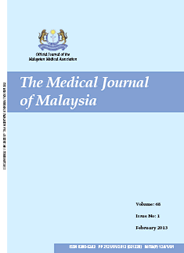MJM, Vol 70 Supplement 1 September 2015
Household food
insecurity in Malaysia: findings from
Malaysian Adults Nutrition Survey
*Nutrition Division, Ministry of Health Malaysia, Putrajaya, **Institute for Public Health, Kuala Lumpur, ***Department of Nutrition and Dietetics, Faculty of Medicine and Health Sciences, Universiti Putra Malaysia, Serdang, Selangor, ****Kulliyyah of Allied Health Sciences, International Islamic, University Malaysia, Kuantan, Pahang
ABSTRACT
Introduction: Food security is an essential universal dimension of household well-being. Food security is usually defined as an access by all people at all times to enough food for an active and healthy life. The deprivation of basic need represented by food insecurity is undesirable.
Objective: To determine the associations between selected household food security parameters and socio-demographic characteristics.
Methods: Data were derived from 3000 respondents participated in the Malaysian Adult Nutrition Survey 2014. Food security parameters were measured based on the modified Short Form of the Household Food Security 6-Item Scale by the USDA. Associations for categorical data were carried using chi-square test for complex sample survey.
Results: The prevalence of Malaysian adults that had both reduced the size of meals and skipped main meals because of financial constraints at least one or two months in the past 12 months was 13.4% (95% CI: 11.5%, 15.5%). This prevalence was significantly higher in East Malaysia (20.3%) than in Peninsular Malaysia (11.5%) and in rural areas (18.8%) than in urban areas (11.0%). It was also highest among households with income <RM3000 (19.1%) and no formal education (45.8%) whereas lowest among household income RM 6000 (2.1%) and tertiary education (6.0%). The prevalence of households that both relied on cheap foods and could not afford to feed their children with food variety because of financial constraints was 18.9% (95% CI: 16.7%, 21.3%). It was significantly higher in East Malaysia (34.5%) than in Peninsular Malaysia (14.8%).
Discussion: Food insecurity is still presence in large segments of the Malaysian households. Therefore, there is a need to review the current strategy to effectively address food insecurity in the country.
Keywords: food quantity, food variety, skip meal, food security, MANS 2014.
